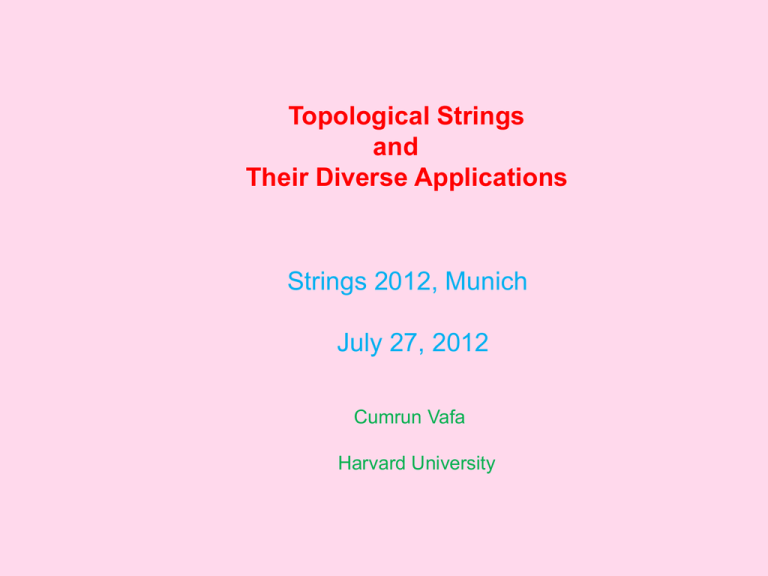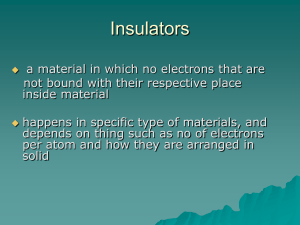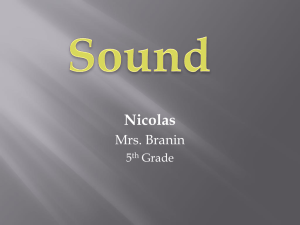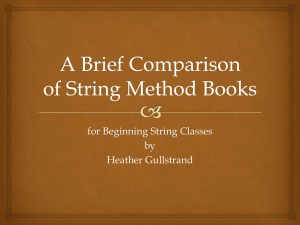ppt - MPP Theory Group
advertisement

Topological Strings and Their Diverse Applications Strings 2012, Munich July 27, 2012 Cumrun Vafa Harvard University Since their introduction more than two decades ago [W1], topological strings have played a key role in many developments in string theory. -A simpler setup where deep aspects of string theory (such as mirror symmetry, and large N duality) can be better understood -Diverse applications to SUSY theories including: counting microstates of BPS black holes strong coupling dynamics Topological Strings have various dual facets: A/B Mirror Symmetry Open/Closed Large N Gauge/Gravity Non-compact/Compact Gauge/Gravity Refined/Unrefined Gauge/Gravity Worldsheet / Target Topological (internal geometry) / Physical (total space) Pertubative / Non-Perturbative My aim in this talk is to give an overview of what we have learned about them and what we are yet to learn. [ACDKV] M.Aganagic, M.C.N.Cheng, R.Dijkgraaf, D.Krefl and C.Vafa, ``Quantum Geometry of Refined Topological Strings,'' [arXiv:1105.0630 [hep-th]]. [AGGTV] L.F.Alday, D.Gaiotto, S.Gukov, Y.Tachikawa and H.Verlinde, ``Loop and surface operators in N=2 gauge theory and Liouville modular geometry,'‘ JHEP1001, 113 (2010). [AGNT] I.Antoniadis, E.Gava, K.S.Narain and T.R.Taylor, ``Topological amplitudes in string theory,'‘ Nucl.Phys.B 413, 162 (1994). [AGT] L.F.Alday, D.Gaiotto and Y.Tachikawa, ``Liouville Correlation Functions from Four-dimensional Gauge Theories,'' Lett.Math.Phys.91, 167 (2010). [AK] H.Awata and H.Kanno, ``Refined BPS state counting from Nekrasov's formula and Macdonald functions,''Int. J. Mod. Phys. A 24, 2253 (2009). [AKMV] M.Aganagic, A.Klemm, M.Marino and C.Vafa, ``The Topological vertex,'‘ Commun. Math. Phys. 254, 425 (2005). [AS1] M.Aganagic and S.Shakirov, ``Knot Homology from Refined Chern-Simons Theory,'‘ [arXiv:1105.5117 [hep-th]]. [AS2] M.Aganagic and S.Shakirov, to appear. [BCOV] M.Bershadsky, S.Cecotti, H.Ooguri and C.Vafa, ``Kodaira-Spencer theory of gravity and exact results for quantum string amplitudes,''Commun.Math.Phys.165, 311 (1994). [BKMP] V.Bouchard, A.Klemm, M.Marino and S.Pasquetti, ``Remodeling the B-model,''Commun.Math.Phys.287, 117 (2009). [BV] N.Berkovits and C.Vafa,``N=4 topological strings,'' Nucl.Phys.B 433, 123 (1995). [CdWM] G.L.Cardoso, B.de Wit and S.Mahapatra, ``BPS black holes, the Hesse potential, and the topological string,'' JHEP1006, 052 (2010). [CDV] M.C.N.Cheng, R.Dijkgraaf and C.Vafa, ``Non-Perturbative Topological Strings And Conformal Blocks,''JHEP1109, 022 (2011) [CLV] M.C.N.Cheng, G. Lockhart, C. Vafa, Work in progress. [CNV] S.Cecotti, A.Neitzke and C.Vafa, ``R-Twisting and 4d/2d Correspondences,'‘ [arXiv:1006.3435 [hep-th]]. [CV] S.Cecotti and C.Vafa,``BPS Wall Crossing and Topological Strings,''[arXiv:0910.2615 [hep-th]] [CCV] S.Cecotti, C.Cordova and C.Vafa, ``Braids, Walls, and Mirrors,''[arXiv:1110.2115 [hep-th]]. [CEHRV] C.Cordova, S. Espahbodi, B.Haghighat, A.Rastogi, C.Vafa, to appear. [CIV] F.Cachazo, K.A.Intriligator and C.Vafa,``A Large N duality via a geometric transition,''Nucl.Phys. B 603, 3 (2001). [DGG] T.Dimofte, D.Gaiotto and S.Gukov, ``3-Manifolds and 3d Indices,'‘ [arXiv:1112.5179 [hep-th]]. [DGNV] R.Dijkgraaf, S.Gukov, A.Neitzke and C.Vafa,``Topological M-theory as unification of form theories of gravity,'‘ Adv.Theor. Math.Phys.9, 603 (2005). [DGS] T.Dimofte, S.Gukov and Y.Soibelman, ``Quantum Wall Crossing in N=2 Gauge Theories,''Lett.Math.Phys.95, 1 (2011). [DHSV] R.Dijkgraaf, L.Hollands, P.Sulkowski and C.Vafa, ``Supersymmetric gauge theories, intersecting branes and free fermions,'‘ JHEP 0802, 106 (2008). [DM] F.Denef and G.W.Moore, ``Split states, entropy enigmas, holes and halos,''JHEP 1111, 129 (2011). [DVV] R.Dijkgraaf, C.Vafa and E.Verlinde, ``M-theory and a topological string duality,''[hep-th/0602087]. [DV1] R.Dijkgraaf and C.Vafa,``Matrix models, topological strings, and supersymmetric gauge theories,'‘ Nucl.Phys.B 644, 3 (2002) [DV2] R.Dijkgraaf and C.Vafa,``Toda Theories, Matrix Models, Topological Strings, and N=2 Gauge Systems,'' [arXiv:0909.2453 [hep-th]]. [DV3] R.Dijkgraaf and C.Vafa,``Two Dimensional Kodaira-Spencer Theory and Three Dimensional Chern-Simons Gravity,'' [arXiv:0711.1932 [hep-th]]. [DV4] R.Dijkgraaf and C.Vafa, ``A Perturbative window into nonperturbative physics,''[hep-th/0208048]. [EO] B.Eynard and N.Orantin, ``Invariants of algebraic curves and topological expansion,''[math-ph/0702045]. [GSV] S.Gukov, A.S.Schwarz and C.Vafa, ``Khovanov-Rozansky homology and topological strings,'‘ Lett.Math.Phys.74, 53 (2005). [GSY] D.Gaiotto, A.Strominger and X.Yin, ``New connections between 4-D and 5-D black holes,'‘ JHEP 0602, 024 (2006). [GV1] R.Gopakumar and C.Vafa, ``On the gauge theory / geometry correspondence,''Adv.Theor.Math.Phys. 3, 1415 (1999) [GV2] R.~Gopakumar and C.Vafa,``M theory and topological strings. 1,2,'‘[hep-th/9809187], [hep-th/9812127]. [HIV] T.J.Hollowood, A.Iqbal and C.Vafa, ``Matrix models, geometric engineering and elliptic genera,''JHEP0803,069 (2008). [HKQ] M.-x.Huang, A.Klemm and S.Quackenbush, ``Topological string theory on compact Calabi-Yau: Modularity and boundary conditions,''Lect.Notes Phys.757, 45 (2009). [HKK] M.-x.Huang, A.-K.Kashani-Poor and A.Klemm, ``The Omega deformed B-model for rigid N=2 theories,''[arXiv:1109.5728 [hep-th]] [IKV] A.Iqbal, C.Kozcaz and C.Vafa, ``The Refined topological vertex,'‘ JHEP0910, 069 (2009). [KLMVW] A.Klemm, W.Lerche, P.Mayr, C.Vafa and N.P.Warner, ``Selfdual strings and N=2 supersymmetric field theory,'' Nucl.Phys. B477, 746 (1996). [KMV] S.Katz, P.Mayr and C.Vafa, ``Mirror symmetry and exact solution of 4-D N=2 gauge theories: 1.,''Adv. Th.Math.Phys.1, 53 (1998). [KS] M.Kontsevich and Y.Soibelman, ``Cohomological Hall algebra, exponential Hodge structures and motivic DonaldsonThomas invariants,'‘ Commun.Num.Theor.Phys.5, 231 (2011). [MNOP] D.Maulik, N.Nekrasov, A.Okounkov, R.Pandharipande, ``Gromov-Witten Theory and Donaldson-Thomas Theory,”I,II, arXiv:math0312059,0406092. [NW] N.Nekrasov and E.Witten, ``The Omega Deformation, Branes, Integrability, and Liouville Theory,''JHEP 1009, 092 (2010). [NS] N.A.Nekrasov and S.L.Shatashvili, ``Quantization of Integrable Systems and Four Dimensional Gauge Theories,'' [arXiv:0908.4052 [hep-th]]. [ON] A.Okounkov, N. Nekrasov, to appear. [OSV] H.Ooguri, A.Strominger and C.Vafa, ``Black hole attractors and the topological string,'‘ Phys. Rev. D 70, 106007 (2004). [OV1] H.Ooguri and C.Vafa, ``Knot invariants and topological strings,''Nucl. Phys. B577, 419 (2000). [OV2] H.Ooguri, and C.Vafa, ``Worldsheet Derivation of a Large N Duality, Nucl.Phys.B641:3 (2002) [Pa] S.Pasquetti, ``Factorisation of N = 2 Theories on the Squashed 3-Sphere,'‘ JHEP 1204, 120 (2012). [P] V.Pestun, ``Localization of gauge theory on a four-sphere and supersymmetric Wilson loops,'‘ CMP313, 71 (2012). [Wa] J.Walcher, ``Opening mirror symmetry on the quintic,'' Commun.Math.Phys.276, 671 (2007). [W1] E. Witten,``On The Structure Of The Topological Phase Of Two-dimensional Gravity,'' Nucl. Phys. B340, 281 (1990). [W2] E.Witten, ``Chern-Simons gauge theory as a string theory,'' Prog. Math. 133, 637 (1995). [W3] E. Witten,``Quantum Field Theory and the Jones Polynomial,” CMP121, 351 (1989). [W4] E.Witten, ``Quantum background independence in string theory,''[hep-th/9306122]. [W5] E.Witten, ``Nonperturbative superpotentials in string theory,'' Nucl.Phys.B 474, 343 (1996). [YY] S.Yamaguchi and S.-T.Yau, ``Topological string partition functions as polynomials,''JHEP 0407, 047 (2004). Outline of my talk: -Define topological strings worldsheet vs. target closed vs. open A vs. B regular vs. refined -Computational techniques: holomorphy and holomorphic anomaly large N-dualities: Chern-Simons Topological Vertex Matrix Models Topological recursion -BPS content of topological strings D=5 spinning black holes D=4 charged black holes Gauge Theory Applications: D=4, N=2 and N=1 Wall-crossing and D=3, N=2 dualities Open Questions IIA String theory: Spacetime dimension = 10 Many questions related to long distance physical properties preserving SUSY get related to minimal area holomorphic maps: Since Minkowski space has no compact cycle this in particular means that the curve maps to a point on : Thus the problem reduces to the study of holomorphic maps from the curves to the Calabi-Yau 3-fold: A-model topological strings is concerned with `counting’ such maps: The `formal’ dimension of such maps for any genus and any choice of the class of the image is zero. When the actual dimension is zero, we count the holomorphic curves weighted by exp(-Area). Otherwise we end up with the computation of certain class on such moduli spaces A-model topological strings is concerned with `counting’ such maps: The `formal’ dimension of such maps for any genus and any choice of the class of the image is zero. When the actual dimension is zero, we count the holomorphic curves weighted by exp(-Area). Otherwise we end up with the computation of certain class on such moduli spaces, giving in general rational numbers: For a fixed genus g, we define the generating function (`Free Energy’) And the partition function is the generating function for connected and disconnected curves of arbitrary genus: D-Branes Type IIA string in addition admits D-branes (A-branes): 3-dimensional objects which fill Lagrangian subspaces of CY A-branes cut open the strings, as usual: In the full superstrings these could be D6 or D4 branes depending on whether they fill the spacetime or a 2d subspace of spacetime. The Lagrangian D-branes can also have multiplicity: Indeed if we consider the Lagrangian submanifold with N D-brane on it, we get U(N) Chern-Simons gauge theory [W2] , with CS coupling constant given by the string coupling constant One can also obtain knot invariants by intersecting this Lagrangian D-brane with another one, intersecting along the knot [OV1]. M-theory Interpretation/Definition [GV2,MNOP,GSY,DVV] M-theory Interpretation/Definition [GV2,MNOP,GSY,DVV] M-theory Interpretation/Definition [GV2,MNOP,GSY,DVV] A-branes and M-theory D6 branes = KK monopoles, CY G2 D4 branes = M5 branes A-branes and M-theory D6 branes = KK monopoles, CY G2 D4 branes = M5 branes A-branes and M-theory D6 branes = KK monopoles, CY G2 D4 branes = M5 branes Refined Topological Strings In the case of non-compact CY with extra U(1) symmetry (part of R-symmetry of N=2) we can refine topological strings However this latter operation does not preserve SUSY, unless we accompany with an extra internal U(1) action: [HIV,CIV] Similarly this can be extended to the open string definition of refined open string amplitudes [ACDKV]. Refined topological strings in the context of knots realize Khovanov invariants [GSV]. The B-Model IIA on CY M = IIB on mirror CY W Z(A-model,M)=Z(B-model,W) B-model: easier to compute genus 0= special geometry Higher genus amplitudes reduce to a field theory on CY quantizing complex deformations known as Kodaira-Spencer Theory [BCOV] In general, no direct target definition, other than mirror statement. For local CY 3-folds given by curves F(x,p)=uv there is a direct definition: Chain of dualities D4 + D6 intersecting on the curve, F=0, with a fermion living on it and a B-field turned on, making the fermion see the Rimeann surface as non-commuting, with [x,p] = string coupling const. B-Branes holomorphic cycles 0,2,4,6 holomprhic CS theories equivalence with Matrix models Refinement: At the level of matrix model beta-ensemble [DV2] similarly a refinement of CS for A-model exists [AS1] Computational Techniques Closed string: use holomorphy (or holomorphic anomaly) Topological string partition function is essentially holomorphic Since moduli space is essentially compact, this allows us to compute it, up to finite data of residues [BCOV] The higher genus B-model can be solved using the fact it is essentially a holomorphic section of a suitable line bundle over the moduli space of CY, and using the compact structure of moduli space, we only need finite data to characterize it by specifying its behavior near singularities of moduli space. Using the fact that singularities have a physical meaning (such as appearance of extra massless hypermultiplets) leads to fixing residues and solving it to a very high order (up to genus 51 for quintic threefold) [HKQ,HKK]. Also efficient techniques have been developed to integrate The holomorphic anomaly equation [YY]. open A-model = Non-compact case -Chern-Simons theory WZW models [W3] compact case- mirror Symmetry [Wa] open B-model = matrix model techniques for non-compact compact case – direct approach Large N Dualities A-model on T ¤ S3 ´ O(¡ 1) + O(¡ 1) ! P 1 [GV1] One can also find a worldsheet explanation of this large N duality [OV2]: Using knot observables, and interpreting it on the closed string side (with no branes) lead to a complete calculation of topological string for arbitrary toric CY 3-folds: Topological Vertex [AKMV] Gluing topological vertex leads to topological A-model partition function for arbitrary toric CY 3-fold using cubic diagrams: Refined version of the topological vertex has also been introduced and lead to computation of refined open and closed amplitudes [IKV,AK,ON,AS2] B-model version: matrix models compute closed string amplitudes [DV1], e.g. for In fact one can push this further: Starting from spectral curve of matrix models it is possible to recover all O(1/N) corrections using recursion relations for objects defined on the curve [EO]. Principle generalized to all B-models (topological recursion) [BKMP]. Interpreted as Ward identities of 2d reduction of KodairaSpencer theory [DV3]. S= R @Á@Á + ! @Á + @Á(@Á) 2 =! Here ! is a 1-form reduction of holomorpic 3-form on CY (which is related to spectral density in MM) Gauge Theory Applications 4d, N=2: Geometric Engineering IIA on A-D-E singularities along curves 4d, N=2 A-D-E gauge theories [KLMVW,KMV] Z(closed; refined) = Z(Gauge theory; Nekrasov) Z(open) = Z(surface operators) Statement here Statement there e.g. Topological Vertex Formalism Nekrasov partition functions reconstructible from a universal triple of surface operators without a bulk theory 4d, N=1 Adding branes 4d N=1 open/close duality, with spacetime filling branes Geometric transition can be interpreted as glueball condensation [CIV] Non-perturbative N=1 F-terms can be computed using planar limit of matrix integrals [DV4] Wall-Crossing formula for 4d BPS States The wall-crossing fomula for N=2 BPS states in 4d [DM,KS] can be reformulated and derived in the context of open A-model (see also other derivations due to GMN): Starting from an N=2 in 4d, the 1-parameter family which leads to N=2 in 3d, necessitates the central charges to move along real lines [CV,CCV] R-flow Consider A-brane on L (or M5 brane on L x MC) Each BPS particle contributes an open string instanton at a time when the central charge vector crosses real line ©° ;s = Q n+ s (1 ¡ q U° ) n where U° is t he Wilson loop along ° Invariance of ZL = < T(©° 1 ;s1 :::©° n ;sn ) > C S under deformations, leads to refined sense of wall crossing formula [DGS]. M5 brane wrapping L leads to a 3d theory L £ R3 4d wall crossing leads to dualities of 3d field theories. Interesting unexpected connection to 2d [CNV]. For example: ZL (Ar g ¡ Doug) = ®(q) = char: GK O cosets Moreover, line operator algebra Verlinde Algebra Also for the simplest class of models (Argyres/Douglas) L will have a geometry of a branched cover, branched over braids [CCV,CEHRV] Braids encode 3d quantum field theory Gauge Theory Partition Functions 4d or 5d N=2 Partition function on S4 or S4 £ S1 [P] The reason we get squares is [NW]: Also, for D=3, N=2 Partition functions [CCV,DGG,Pa]: BPS/ Black Hole Count There are two different cases where topological string makes contact with Black Hole entropy/count of BPS states: 1- 5d spinning charged black holes: counting M2-branes on the Calabi-Yau 3-fold 2-4d charged black holes: IIA on CY 3-fold string from 10 down to 4 dim. bound states of D0,2,4,6 It connects to 4d electric and magnetically charged black holes. This involves asymptotic expansion of the count. 5d Black Holes Z t op Y = n+ s (1 ¡ q d~ n N d~; s ~ Q ) n ;s; d~ [GV2,BCOV,AGNT] ~ ~ Q = et ; q = e¸ N d;s ~ = degeneracy of BH d~ 2 H 2 (M ) s = SU(2) L spin 5d rot at ion group SO(4) = SU(2) L £ SU(2) R Refined BPS states in 5d Z rt op ef i n ed Y = (1 ¡ n ;m ;sL ;sR ; d~ q1n + sL q2m + sR d~ N d~; s L ; s R ~ Q ) 4d Black Holes [OSV,CdWM] Asymptotic growth of charged 4d BPS black holes IIA on Calabi-Yau Bound states of D0,D2,D4,D6 Charged BPS black holes in 4d Similar statement for the IIB on CY and D3 brane BPS states Note that topological string moduli, including coupling constant captured by X: Let us define: Reminiscent of line operator [AGGTV] for [AGT] Open Questions Non-perturbative meaning? Holomorphic anomaly can be interpreted as a choice of polarization for wave function [W4] Consistent with M-theory interpretation on non-compact space Can this relation be made precise? Could there be a relation to a 7d theory? G2 holonomy manifolds? [DGNV] The [NS] limit of refined topological string leads to open string wave function which is annihilated by the CY curve [ACDKV] Understand more clearly what happens away from NS limit as well as the closed string analog. Does irrational moduli make sense non-perturbatively? [AGT] correspondence suggests it does. In the context of conifold this would imply U(N) matrix model or U(N) CS makes sense for irrational values of N [CLV]. Also this correspondence suggests identification of topological string amplitudes with chiral blocks [CDV]. What is the meaning of the structure of CFT’s for topological strings? How about N=4 topological string [BV] ? Its target is 2 complex dimensional CY (hyperkahler geometries). How much of this structure can be carried over to there? open/closed duality? What are their gauge theory implications? (it should be applicable to theories with 16/8 supercharges) It is natural to expect more generally that topological strings should be generalized to topological branes. This would include not only the aspects discussed for topological strings but all contexts in which branes wrapping internal geometries preserve enough supersymmetry, such as M5 branes wrapping 4-folds [W5]. Topological Branes = Supersymmetric Branes Topological branes includes most of what we currently know about superstrings. Conclusion Since its introduction, over 20 years ago, topological strings has been a source of inspiration for many developments in string theory. It continues to be a subject of active interest. It seems clear that this subject will continue to be studied very actively for many years to come. There is a lot more physics that we expect to extract from this beautiful subject!









